Wireless
MWC 2024 Buzz Signals Continuing Momentum for 5G and Other Mobile Technologies
Key Points
- Hot topics at MWC 2024 in Barcelona included 5G, Network as a Service (NaaS), AI, Open RAN and more.
- Although there were fewer announcements about disruptive, new 5G technologies than in recent years, activity during MWC suggested overall forward movement is continuing in the development of 5G solutions.
Mobile World Congress (MWC) is the flagship conference for the mobile industry, where vendors and mobile operators showcase new products, technologies and solutions. The buzz at the annual trade show translates to the pulse of the mobile industry and offers a sneak peek at its direction.
This year at MWC Barcelona, more than 100,000 participants attended from 200-plus countries, and more than 2,700 small and large vendors and operators were on exhibit across eight halls. The level of activity at the event was on par with pre-pandemic levels.
Here are a few general observations and themes from this year’s MWC.
‘Show Me the Money’
Every year, there is huge anticipation for announcements about disruptive technologies or new solutions in the mobile industry. This year, the impact of new developments and disruptive 5G solutions was muted compared with years past — somewhat expected, as operators are still undergoing 4G-to-5G network transitions, awaiting releases to complete their fully featured 5G networks.
Operators who haven’t yet seen the expected monetization from their 5G build-outs are cautious about upcoming investments toward continuing the rollout of the network. Overall, a limited number of solutions showcased at the show could be categorized as “money-making” for operators.
However, the news wasn’t all negative! Vendors and operators demonstrating Network as a Service (NaaS) solutions were pretty common. CableLabs even presented a demonstration illustrating potential applications of NaaS on the fixed network.
In addition, the event partner co-located with the MWC — “4 Years From Now” (4YFN) — had its largest-ever showing, with start-up and venture-capital companies coming together to showcase the state of what’s possible with 5G networks. This was a very popular part of the show.
AI Will Enhance Efficiencies in 5G
Artificial intelligence (AI) was a common theme among 5G vendors and operators demonstrating efficiencies in 5G service delivery, throughput, operations and performance. However, nothing was truly disruptive.
The AI solutions were focused on operator-specific network improvements to squeeze out 5G network performance, using AI to improve their return on investment (ROI) in place of spending on additional 5G network rollout.
In addition, AI was generally tailored to vendor-operator partnerships for specific 5G network improvements and use cases using prototype solutions still under development. Overall, the role of AI in 5G networks was a hot topic, but there were no clear answers to questions about how the technology might ultimately impact the industry.
Network Virtualization and Disaggregation Continues to Advance
Network operators and vendors continue to disaggregate network components and virtualize network functions as shown by many advanced solutions on exhibit for the 5G core and RAN. This includes both operator-based on-premises virtualization along with cloud-based services from third-party service providers. This shows the continuing network evolution toward virtualization, providing new services, reducing costs and enhancing operational efficiencies.
6G Still in Early Stages
There was little 6G activity. Most of the 6G activity was centered around test equipment to help enable and develop ideas and proof of concepts. With 5G still being deployed and a few years from its full features, it seems that 6G is in the early stages of ideation in the academic, vendor development and standards community.
Open RAN Continues to Gain Momentum
Open RAN vendors showcased further evolution of disaggregated and virtualized RAN solutions, featuring more capabilities and more availability of common uses that include macro cells, small cells, fixed-wireless access (FWA) and private networks. Improved functionality included higher-level MIMO RU solutions such as 32×32 and 64×64 MIMO in the mid-band.
There was also advancement in RAN Intelligent Controller (RIC) and Service Management and Orchestration (SMO) platforms, with various Open RAN partnerships showcasing capabilities closer to commercial operation. Again, in many cases, these advances were specific to operator and vendor partnerships, so Open RAN via the O-RAN Alliance has a ways to go before realizing its final vision.
Other Hot Topics
Other topics discussed at the show included the following:
- The Internet of Things (IOT) remains a potential key trend for 5G networks. Vendors and operators alike showcased many use cases and product solutions.
- The use of non-terrestrial networks (NTNs) for mobile communications is starting to make progress. Advances in satellite technology are making the technology a viable option for traditional voice communications in unserved rural areas and as a backup alternative during network outages.
- Energy efficiency and sustainability continue to be top of mind for operators. Most vendors are providing solutions to help drive down energy consumption and improve long-term sustainability.
All in all, the buzz at MWC was relatively quiet with no major announcements or industry disruptions related to these and other mobile technologies. However, considering the large attendance, the conference was filled with lots of activity and steady forward movement in 5G development. This could bode well for the industry as it continues with its 5G rollout.

Wireless
Open RAN Momentum: A Year of Technological Evolution

Key Points
- Advancements in Open RAN over the past year are evidence that it continues to evolve toward adoption.
- Open Testing and Integration Centers (OTICs) around the world — including one at Kyrio, a CableLabs subsidiary — enable cooperation among vendors.
The Open RAN ecosystem has continued to evolve over the past year, taking major steps forward and gaining more credence and industry acceptance. In case you’re not up to speed, here’s an at-a-glance view of some of these promising new developments.
Significant new investments are driving scale and innovation.
- In September, Vodafone and Samsung kicked off a massive deployment of 2,500 disaggregated and virtualized cell sites, providing 4G and 5G services across the United Kingdom.
- In September, Ericsson announced it will introduce support for open fronthaul across its Cloud RAN and radio portfolios starting this year. In December, AT&T committed to large-scale Open RAN and selected Ericsson as its vendor.
- The NTIA awarded the first grants from the Public Wireless Supply Chain Innovation Fund program for Open RAN technologies in 2023 and a recent round in early 2024 to academic institutions, DISH and Viavi.
- In addition, the U.S. Department of Defense announced that it will invest in private Open RAN 5G to leverage innovation in that ecosystem.
Maturing RIC and automation gear up for differentiating performance and efficiency.
- Vodafone has been vocal about its Open RAN deployments, delivering performance as good as or better than that of the company’s traditional RAN sites.
- DISH reported record-low cost due to highly efficient operations and automation.
- Open RAN vendors such as Mavenir are marketing artificial intelligence/machine learning (AI/ML) solutions that make full use of the data exposed by open interfaces.
- At the Open RAN North America conference in December, multiple operators discussed the intricacies and maturity of their evolving RIC implementations.
- The U.S. government is propelling RIC advancements: In March, the agency will host a RIC forum with live demonstrations of leading vendors’ RIC capabilities.
New OTICs and service offerings facilitate integration and adoption.
- Integrating various vendors’ gear to work together is one of the key challenges for Open RAN adoption. Open Testing and Integration Centers (OTICs) like the one at CableLabs’ subsidiary, Kyrio, facilitate this kind of cooperation, hosting multiple PlugFests to advance Open RAN features and performance. Several new OTICs have been added in 2023, most recently at MITRE in the U.S. and a group of companies in South Korea.
- Several operators and vendors, including Docomo and Ericsson, have announced new service offerings and pre-integrated configurations to ease Open RAN adoption.
Although there’s still a long way to go before Open RAN architectures become widely adopted, these advancements show that the technology is steadily evolving and here to stay.
If you’re planning to attend Mobile World Congress/MWC Barcelona this month, join us for the O-RAN ALLIANCE Summit. The summit is the first major gathering of this community in conjunction with an MWC event, further underscoring the industry’s continued interest in Open RAN.

Wireless
New Release of Wi-Fi Certified Vantage™ Continues to Improve the Wi-Fi User Experience

Wi-Fi CERTIFIED Vantage™ is a certification program created within the Wi-Fi Alliance® that makes it easy to select devices that provide an enhanced Wi-Fi experience in managed Wi-Fi networks. The latest release is now available (as of September 2020). This is the culmination of over a year’s worth of collaboration within the Wi-Fi ecosystem under CableLabs’ leadership that delivers feature-rich devices to improve Wi-Fi user experience.
The primary goal of the Wi-Fi Vantage certification program is to provide a more reliable and higher-performance user experience than unmanaged best-effort Wi-Fi networks can provide. The Wi-Fi Vantage certification program designates a highly developed set of Wi-Fi technologies optimized for managed Wi-Fi networks that directly address Wi-Fi managed network operator needs.
Wi-Fi Vantage bundles pertinent Wi-Fi Alliance certifications that improve overall network performance, deliver the latest in Wi-Fi security and encryption standards, and alleviate congestion on mobile data networks. Wi-Fi Vantage delivers a more reliable and consistent connectivity experience for users when they’re establishing network access, onboarding devices, accessing services and traversing Wi-Fi networks.
Wi-Fi Vantage will continue to be available for Wi-Fi 5 generation devices, and Wi-Fi Vantage certification for Wi-Fi 6 will now include advanced features:
- Wi-Fi 6 and Wi-Fi 5
- Wi-Fi CERTIFIED WPA3™
- Wi-Fi CERTIFIED Passpoint®
- Wi-Fi CERTIFIED Enhanced Open™
- Wi-Fi CERTIFIED Agile Multiband™
- Wi-Fi CERTIFIED Optimized Connectivity™
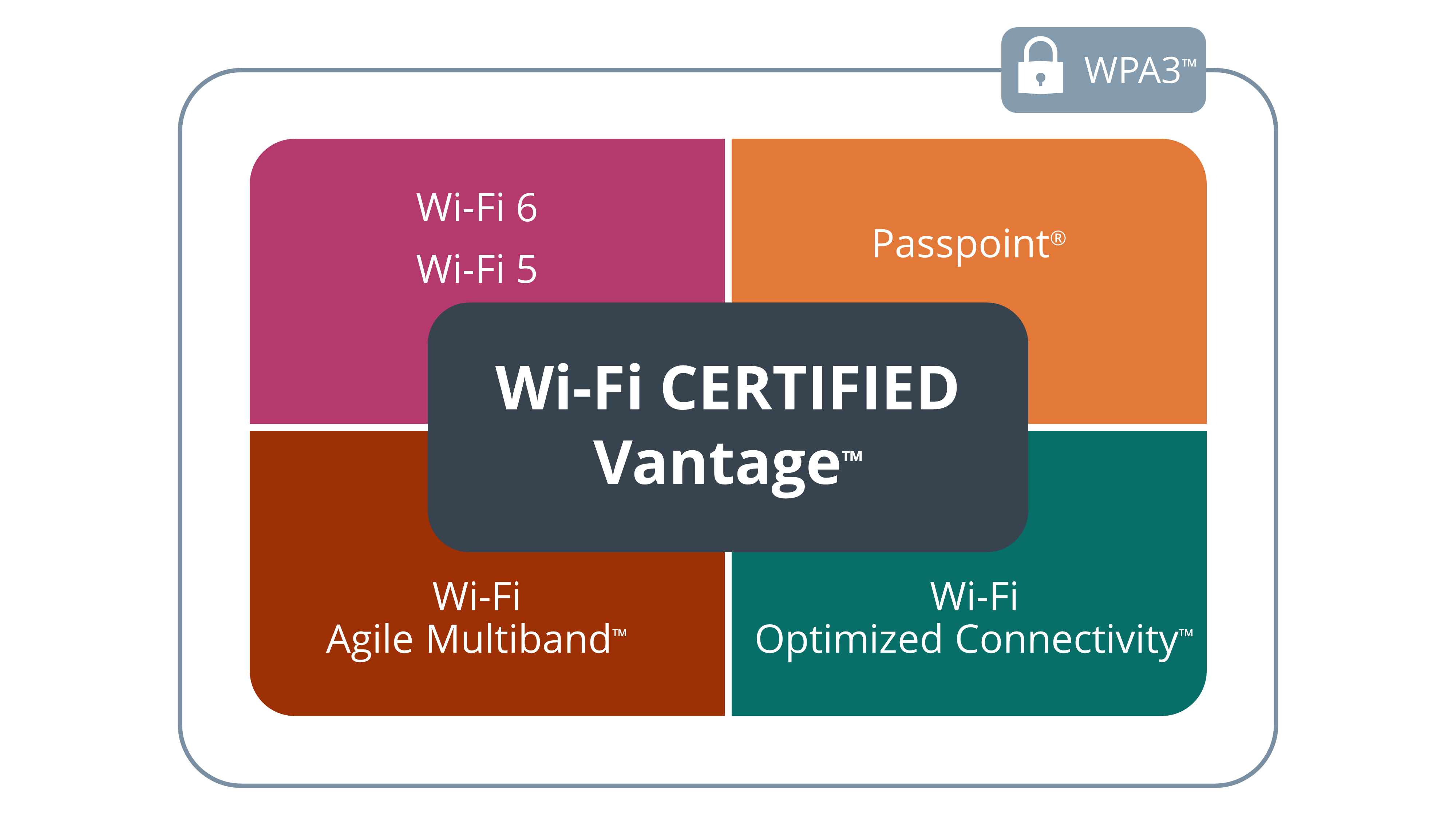
Vantage Evolution
The newest generation of Wi-Fi Vantage Release 3 includes newly developed IEEE 802.11 features and state-of-the-art Wi-Fi technology that can be used in a broader base of operator-managed environments, including public, residential and enterprise. Vantage Release 3 adds Wi-Fi 6, Wi-Fi and WPA 3, and Enhanced Open certifications that deliver higher data rates, less congestion, more user capacity and superior security.
Wi-Fi Vantage will continue to evolve incorporating the latest technologies, giving users the most enhanced Wi-Fi experience available. Each new generation of Wi-Fi Vantage devices will provide improved device performance and reduced network connection times when customers access managed Wi-Fi networks.
As Wi-Fi data usage and user applications continue to grow, those factors introduce strain on the Wi-Fi network that impacts user experience and Wi-Fi network operation. Strains such as maintaining connection, reliable service delivery and spectrum interference/management are some of the common challenges Wi-Fi operators are trying to overcome.
The collective feature set of Wi-Fi Vantage was built to address these strains. For example, the Wi-Fi Vantage features of enhanced network discovery and advanced roaming have been trialed and demonstrated to improve performance in network connection by decreasing setup times by 76 percent and reducing management frame and beacon congestion an average of 70 percent compared with the performance of non-certified Wi-Fi Vantage devices. This is just one example of how Wi-Fi Vantage devices use unique features to overcome Wi-Fi network strains on managed networks.
Wi-Fi CERTIFIED Vantage™ Benefits to Network Operators
- Streamlined product procurement decisions
- Improved network performance and resource management
- Consistent coverage across network
- Ability to influence client roaming behavior
- AP load balancing
- Latest Wi-Fi security and encryption standards
- Quality user experiences
- Data offload
Wi-Fi CERTIFIED Vantage™ Benefits to Users
- Simpler, light or no-touch access
- Secure onboarding
- Faster speeds
- Consistent, reliable coverage
- Seamless transitions from Wi-Fi to cellular
The Wi-Fi Vantage feature set definition is driven by the operator community within the Wi-Fi Alliance that consists of Wi-Fi industry experts who have a pragmatic understanding of operator needs. A dedicated task group, led by CableLabs, was created in the Wi-Fi Alliance to address and develop certifications to meet these needs. CableLabs will continue to work with the Wi-Fi ecosystem to identify common Wi-Fi operator network strains and develop collaborative solutions in the form of standards certification.
Read more about Wi-Fi Vantage, including an animation and WFA overview papers: Wi-Fi CERTIFIED Vantage Enhancing the managed Wi-Fi network experience and Wi-Fi CERTIFIED Vantage™ Technology Overview.

Wireless
Field Trial Results Show Wi-Fi CERTIFIED Vantage™ Devices Offer Significant Improvement to Network Performance

 In a high-traffic, high-volume user environments such as subways, airports, and stadiums, maintaining a reliable connection and moving consistently across access points (APs) in a Wi-Fi network has always been a challenge for users and operators. A solution to this issue is now commercially available in the form of Wi-Fi CERTIFIED Optimized ConnectivityTM and Wi‑Fi CERTIFIED Agile MultiBandTM AP and client devices. These are core certifications to the WFA Wi-Fi CERTIFIED VantageTM program. These Wi-Fi Vantage TM devices contain features that optimize management and control frame transmissions, network discovery, authentication, and network transition. A field trial was conducted to measure the performance of a Wi‑Fi network using of Wi-Fi Optimized ConnectivityTM and Wi‑Fi Agile MultiBandTM devices embedded in a highly congested urban environment centered around a busy subway station. Results show the following improvements over non-Wi-Fi Vantage devices:
In a high-traffic, high-volume user environments such as subways, airports, and stadiums, maintaining a reliable connection and moving consistently across access points (APs) in a Wi-Fi network has always been a challenge for users and operators. A solution to this issue is now commercially available in the form of Wi-Fi CERTIFIED Optimized ConnectivityTM and Wi‑Fi CERTIFIED Agile MultiBandTM AP and client devices. These are core certifications to the WFA Wi-Fi CERTIFIED VantageTM program. These Wi-Fi Vantage TM devices contain features that optimize management and control frame transmissions, network discovery, authentication, and network transition. A field trial was conducted to measure the performance of a Wi‑Fi network using of Wi-Fi Optimized ConnectivityTM and Wi‑Fi Agile MultiBandTM devices embedded in a highly congested urban environment centered around a busy subway station. Results show the following improvements over non-Wi-Fi Vantage devices:
Optimized Network Discovery
Without Wi-Fi Vantage, the inefficiencies of network discovery and response messages can severely disrupt existing client connections and make it difficult for clients to attach to the network. The optimized network discovery features in Wi-Fi Vantage include suppression of, and broadcast of, probe responses by the AP and also include probe request deferral and suppression by the client. Field trial results show that the number of probe responses in a Vantage network were reduced by 76% on the 2.4 GHz radios and by 72% on the 5 GHz radios. This resulted in a probe response airtime usage reduction of 67% in 2.4 GHz and 44% in 5 GHz.
Optimized Authentication
Without Wi-Fi Vantage, clients can experience long reconnection setup times when moving back into a previously-joined network. With Wi-Fi Vantage, this re-connection setup time is reduced using Fast Initial Link Setup (FILS) Authentication. When FILS Authentication was tested in the Wi-Fi Vantage network, results showed that the connection setup times decreased by 76% (from 228 ms to 55 ms).
Fast Network Transition
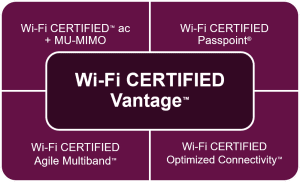 Without Fast Network Transition (FT), clients must perform a full Extensible Authentication Protocol (EAP) when roaming, possibly interrupting the end-user experience. With Wi-Fi Vantage, once a client device decides to roam to a different AP, band, or channel, the association and connection happen quickly and seamlessly. Test results show that FT roaming improved client re-connection setup times by 84%, reducing it from 203 ms to 31 ms. In addition, Fast Network Transition can be deployed with, and will work alongside, FILS Authentication to further optimize client connections and roams.
Without Fast Network Transition (FT), clients must perform a full Extensible Authentication Protocol (EAP) when roaming, possibly interrupting the end-user experience. With Wi-Fi Vantage, once a client device decides to roam to a different AP, band, or channel, the association and connection happen quickly and seamlessly. Test results show that FT roaming improved client re-connection setup times by 84%, reducing it from 203 ms to 31 ms. In addition, Fast Network Transition can be deployed with, and will work alongside, FILS Authentication to further optimize client connections and roams.
A full-featured Wi-Fi Vantage network will benefit overall network performance and user experience, especially in high-traffic, high-volume environments. Some Vantage features may already be included in operator-managed Wi-Fi networks using vendor-specific implementation and nomenclature. Field trial results will allow operators to assess the value of a partial- or full-featured Vantage certified Wi-Fi network. CableLabs’ joint leadership with the operator community (cable and mobile operators) created the vision and roadmap for the Wi-Fi Vantage program while partnering with the Wi-Fi ecosystem and will continue these efforts for the next generation of Wi-Fi Vantage.

Wireless
Operators Now Have the (ad)Vantage™

The first Wi-Fi–certified Vantage™ Access Point device became commercially available last month. This is a milestone because it means the Wi-Fi industry is beginning to incorporate carrier-grade Wi-Fi features into Wi-Fi devices. This will benefit operators’ ability to better manage Wi-Fi networks, which—in turn—will benefit users by delivering an elevated quality of experience.
The Wi-Fi Alliance conceived Vantage™ (the Wi-Fi Alliance’s brand name for carrier-grade Wi-Fi) as a way to provide solutions to operator needs in conjunction with priorities set by Wi-Fi device vendors. Many of the Wi-Fi devices today use IEEE 802.11 features in their baseline design yet implement proprietary features to enhance performance and provide product differentiation. Although this can be beneficial to the user, it can also lead to inconsistent performance if users utilize a variety of Wi-Fi devices with different feature enhancements.
Vantage™ devices attempt to overcome this potential inconsistency by introducing a common set of 802.11 features to meet common operator needs. Such needs include:
- Enhancements to network connection
- Connection times
- Network attachment
- Faster speeds—most important in high-density, dynamic Wi-Fi network environments that have a high concentration of users.
For example, have you ever experienced slower data speeds on a Wi-Fi network when people exit at a subway station stop? Or lose your connection while waiting at an airport gate when a high volume of passengers deboard? Or find that the text you sent is delayed at a baseball game during the 7th inning stretch?
Vantage™ leverages these key technologies into a single device as a basis for its solution to operator needs:
- Wi-Fi CERTIFIED™ ac: high-performance, dual-band operation
- Wi-Fi CERTIFIED Passpoint®: secure, light-touch authentication
- Wi-Fi CERTIFIED Agile Multiband™: efficient use of spectrum, smart steering
- Wi-Fi CERTIFIED Optimized Connectivity™: improved roaming, efficient transmissions
Wi-Fi Vantage™ devices offer features that provide automatic, seamless, secure access to Wi-Fi networks and mechanisms for efficient use of spectrum and network resources in densely populated, dynamic environments. It also allows operators to deliver an elevated user experience, increased data rates and the ability to allow more devices to operate on the same network without sacrificing performance.
CableLabs’ joint leadership with the operator community (mobile and cable operators) created the vision and roadmap for the Vantage™ program while partnering with the Wi-Fi ecosystem. The Vantage™ certification process has been completed, and the operators and industry are now waiting for more Vantage™ Access Points and user devices to become commercially available to improve managed Wi-Fi networks and deliver optimal user experience.
To learn more about Vantage™ in the future, subscribe to our blog.

Wireless
Carrier Wi-Fi is now Wi-Fi CERTIFIED Vantage™

The recent announcement by the Wi-Fi Alliance of the new certification designation, Wi-Fi CERTIFIED Vantage™, is a significant step for the industry. It is the culmination of years of collaboration within the Wi-Fi ecosystem and the result of incorporating industry established Carrier Wi-Fi requirements into industry certified Wi-Fi devices.
Wi-Fi Vantage devices will provide improved performance to users in managed Wi-Fi networks and make it easier to maintain quality connections in high usage environments including stadiums, airports, offices, campuses and home networks. Wi-Fi Vantage leverages current technologies that include Wi-Fi Alliance-certified Wi-Fi ac and Passpoint and will use subsequent releases to build upon using upcoming technologies and features. Ultimately, this accomplishment provides a mechanism for Wi-Fi operators to harden their networks to evolve from ‘best effort’ networks to operator-managed networks that will approach the reliability and functionality of mobile networks.
CableLabs is pleased to be part of the process to build this framework for Wi-Fi Vantage with Wi-Fi industry partners. We look forward to continued success in building upon the framework to benefit cable and mobile operators, the vendor community and, most importantly, consumers.
Collaboration Brings New Capabilities
Establishing solutions to the largest challenges faced by Wi-Fi operators, including cable operators, in the form of industry certifications has been the focus of CableLabs and many industry organizations. Some of the significant challenges collectively include: sticky client, secure and seamless access and connection, device provisioning, fast AP to AP handoffs in a secure SSID environment, load balancing across bands, and RF performance characterization for APs and clients.
Wi-Fi Vantage certified devices will be capable of resolving several of these challenges such as improved secure on-boarding of new clients, better customer experience when moving on a secure network, automatic discovery and attachment to roaming partner networks per operator driven network selection policy, and fast transitions across APs on secured networks to ensure subscribers receive the best performance available in the area.
Key Features of the First Release of Wi-Fi Vantage™
Wi-Fi Vantage is the technology suite operators will employ to deliver an exceptional user experience and help create the Wi-Fi preferred generation. More specifically, Wi-Fi Vantage delivers superior performance on global networks without intervention or effort from subscribers. Wi-Fi users are up and running on reliable networks with their favorite applications anywhere they roam simply by powering on their device. Wi-Fi Vantage will be the preferred service of a new generation of wireless data users by employing a number of superior service benefits including:
- Performance: Wi-Fi Vantage addresses the problem of inconsistent performance of Wi-Fi networks. Wi-Fi Vantage employs 802.11ac for the fastest throughput available on Wi-Fi technologies. Multi-band operations at 2.4 GHz, 5.0 GHz and future unlicensed bands ensure that all available spectrum is employed to deliver a superior subscriber experience.
- Device Provisioning and Operator Policy: Wi-Fi Vantage devices and provisioning systems support a single, standard interface for operators to provision and maintain user subscriptions, secure SSID profiles and network selection policy.
- Guest Network and Online Sign Up: Operators can provision and enforce policy for guest access on Wi-Fi Vantage networks and allow visitors to access guest networks without requiring visitors to sign up each time they enter a network. Operators can dynamically establish new user accounts, and create policy and customized accounts (ie. 1-day, 30-days, etc).
- Roaming: Wi-Fi Vantage will make pervasive, ubiquitous wireless connectivity a reality for users in major cities around the world.
Improving the Wi-Fi Experience
Cable operators are deploying millions of Access Points (APs) with public Service Set Identifiers, (SSID)s in their networks and linking their networks together into roaming consortiums in order to meet accelerating wireless data service demand. Wi-Fi Vantage brings the scale required to support roaming onto hundreds of roaming partner networks throughout the world with a single subscription. Wi-Fi operators can share their networks without having to provide and manage subscriptions separately. Wi-Fi devices automatically discover and attach to roaming partner networks per operator driven network selection policy.
Roaming starts at home and extends its reach to local, domestic and international networks. Cable operators and others are deploying public SSIDs in residential and small business APs to provide extensive Wi-Fi coverage for their subscribers. Wi-Fi Vantage provides network selection intelligence to help subscribers move onto their private networks while at home, and then roam onto neighborhood networks via public SSIDs on residential gateways. This roaming then extends to large operator managed outdoor metro networks, and finally, to Wi-Fi networks across nations and continents. Wi-Fi users will see their operators providing them with an integrated, extensive global Wi-Fi service.
Wi-Fi Vantage technologies provide a number of superior service elements for operators including performance, policy and provisioning and roaming. By delivering this exceptional user experience, Wi-Fi Vantage will be the preferred service of a new generation of wireless data users.
Mark Poletti is Director of Wireless Technologies at CableLabs.
Labs
Are all Wi-Fi Channels Created Equal?

Wi-Fi & RF Performance
Over the years, Wi-Fi networks have evolved into planned, managed networks, delivering faster data rates and reliable service using outdoor Hotspots, Enterprise access points (AP), and Homespot gateways. As Wi-Fi Operators continue to rollout and expand Wi-Fi networks, ensuring reliable service and quality is a critical goal. ‘Carrier Grade Wi-Fi’ is an industry movement that will offer solutions and features to harden Wi-Fi infrastructure and sustain connectivity to achieve this. One main area of focus is RF performance of a Wi-Fi device. Maintaining consistent RF performance across all Wi-Fi devices and across all Wi-Fi channels will provide a more consistent RF link budget and dependable link balance. This will enable Wi-Fi Operators to provide reliable and quality network performance and deliver consistent data rates at expected ranges.
Making Wi-Fi Better
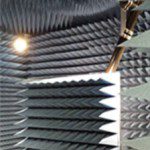 To facilitate the best customer experience on behalf of its members, CableLabs is collaborating extensively with the Wi-Fi industry to provide studies, standards, methodologies and solutions to establish RF performance criteria for Wi-Fi devices. To provide vendor-neutral unbiased test results to the cable industry, CableLabs tests Wi-Fi devices using industry and customized test plans using an anechoic chamber. The goal of our work is to establish RF performance criteria of a Wi-Fi device by assessing hardware design, device performance, and network performance.
To facilitate the best customer experience on behalf of its members, CableLabs is collaborating extensively with the Wi-Fi industry to provide studies, standards, methodologies and solutions to establish RF performance criteria for Wi-Fi devices. To provide vendor-neutral unbiased test results to the cable industry, CableLabs tests Wi-Fi devices using industry and customized test plans using an anechoic chamber. The goal of our work is to establish RF performance criteria of a Wi-Fi device by assessing hardware design, device performance, and network performance.
The Unexplored Territory of Wi-Fi: RF Performance
CableLabs has completed an initial set of RF performance tests on Wi-Fi devices using its in-house RF anechoic chamber with a state-of-the-art Over-The-Air (OTA) measurement system. RF test measurements follow an industry-based CTIA/WFA (Cellular Telecommunications Industry Association/Wi-Fi Alliance)[1] methodology and test plan. Of particular interest is the measured RF power of a Wi-Fi device. The Wi-Fi industry has adopted a measurement from the cellular industry called ‘total radiated power’ (TRP). TRP is the measurement of the overall RF power of the Wi-Fi device in an RF free environment (i.e. anechoic chamber) taken at multiple positions (every 15 degrees) as shown in Figure 1.
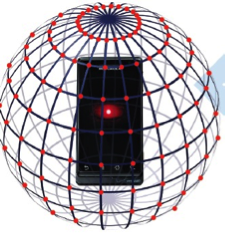
Figure 1. TRP measurement positions following CTIA test plan[2]
TRP is a standard and repeatable method that provides RF characterization of the Wi-Fi device radio and antenna chain as a whole system. TRP is used to characterize the RF performance of transmitter portion of the device.
All Wi-Fi devices must meet ‘not-to-exceed’ regulatory limits that address safety and interference protection to co-existing and adjacent channel inhabitants in unlicensed spectrum. However, historically, there are no minimum RF performance requirements that enforce consistent performance for Wi-Fi devices. Having no minimum RF performance requirements for Wi-Fi devices can introduce inconsistency and variation into Wi-Fi network performance.
Wi-Fi Channel Performance
Results of an initial set of RF characterization measurements on five commercially available Wi-Fi Access Points are shown in Figure 2. The TRP was measured on the low, middle and high channels (1, 6, and 11) in the 2.4 GHz band. The results show a variance in TRP performance within a single access point and across APs on three commonly used channels in the 2.4 GHz band. Such variances make it challenging for a Wi-Fi Operator to provide reliable service and manage a network.
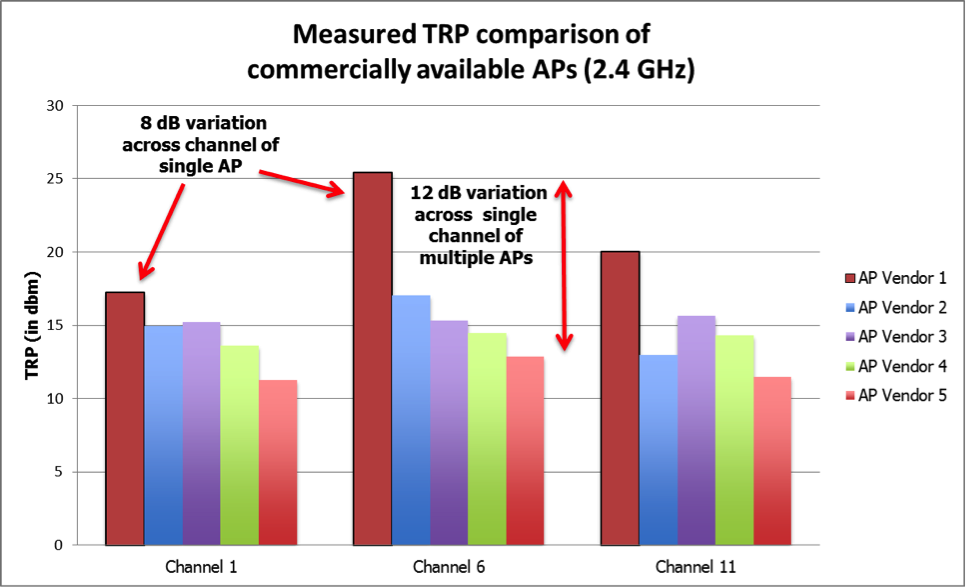
Figure 2. Measured TRP Results of AP vendors illustrating variance within single AP and across multiple AP vendors
The significance of these variances to a Wi-Fi user is shown by using an RF indoor prediction tool to generate coverage differences between two channels of an AP in a common residential house floor plan. Figure 3 uses TRP measurements of AP Vendor 1 to illustrate how two different channels can have different downlink coverage at the same data rates. The heat maps shows that Channel 6 covers 20% greater 65 Mbps coverage than Channel 1 of a 2300 square foot residential home.
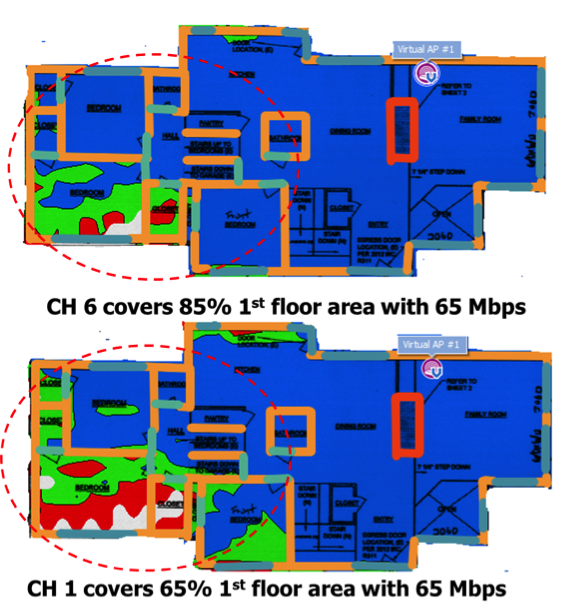
Figure 3. Downlink coverage prediction of typical residential floor plan using measured TRP Results
Wi-Fi and You, Today
While the above studies will help cable operators effectively manage the overall Wi-Fi network across a neighborhood, consumers with wireless routers in their homes can also perform some easy steps to assure the strongest signal strength. This blog provides some tips.
Mark Poletti is a Wireless Architect at CableLabs. Neeharika Allanki is an architect at CableLabs.
[1] http://www.ctia.org/policy-initiatives/certification/certification-test-plans
[2] http://www.ctia.org/policy-initiatives/certification/certification-test-plans
Networks
Carrier-Grade Wi-Fi Keeps Pace With Wi-Fi Network Growth: How CableLabs is Contributing

“Operators of all kinds – fixed, mobile, converged and pure-play Wi-Fi – are moving beyond using Wi-Fi just for convenient access, or data offload, and are making it a central part of their broader strategies to support a high quality broadband experience everywhere.”
(Excerpt from WBA Industry Report 2013: Global Trends in Public Wi-Fi p3)
Over the past few years Wi-Fi networks have seen substantial growth in the number of hotspots to deliver expanded coverage and new service offerings. Wi-Fi networks offer unique characteristics, such as very high data rates (50 Mbps up to 400 Mbps using 802.11n), easy connection to neutral hosts, and unlicensed shared spectrum. Hotspots have very small coverage and are especially useful in areas with dense population. This is very attractive to 3G/4G cellular carriers experiencing congestion due to spectrum and network capacity limitations. Cellular networks experiencing such congestion use Wi-Fi networks to offload cellular data to maintain service and data integrity.
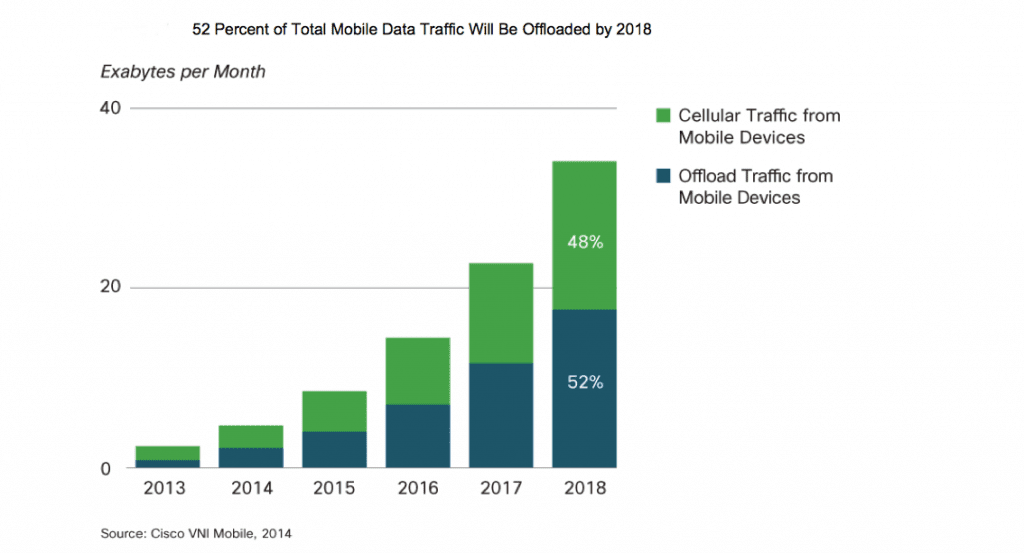
The Wireless Broadband Association (WBA) projects that 22% of new carrier capacity will come from Wi-Fi networks in 2014.
Wi-Fi network operators are exploring opportunities beyond 3G offload that will offer differentiated services to their core business. For example, Wi-Fi network operators, such as mobile operators (MNOs) and cable operators (MSOs), offer service plans that enhance (e.g. from fixed cable to wireless used by cable operators) or extend (e.g. mobile to Wi-Fi used by T-Mobile, Verizon) existing service. As mobile and Wi-Fi services continue to overlap and converge, the integration of mobile and Wi-Fi networks, such as that used for 3G to Wi-Fi network handoff, will continue to become increasingly prevalent and more complex.
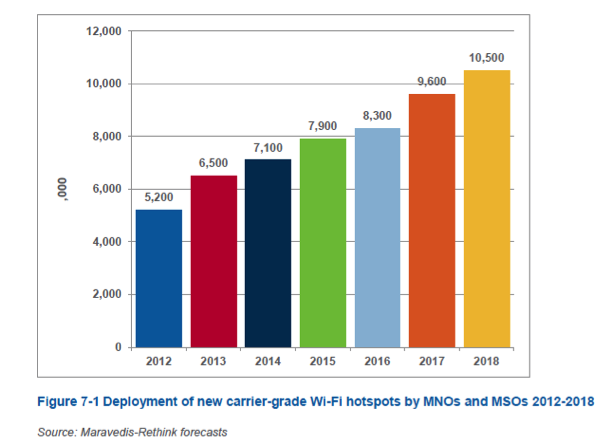
(Excerpt from WBA Industry Report 2013: Global Trends in Public Wi-Fi)
Vision of Carrier Grade Wi-Fi
As Wi-Fi networks are used for faster and more robust data, video, and voice services, maintaining a quality-user experience is becoming increasingly important. “Carrier grade Wi-Fi” is a phrase used for an industry effort to improve Wi-Fi network design, management, and performance to closely match that of cellular networks within the inherent limitations of Wi-Fi. The carrier grade Wi-Fi effort touches all aspects of the Wi-Fi ecosystem including vendors, operators, chipset manufacturers, industry groups, and standards bodies.
Wi-Fi was created to share unlicensed spectrum on a non-interfering basis with autonomous performance and control for any number of users. As industry and market demand has evolved over the years, Institute of Electrical and Electronics Engineers (IEEE) standards and industry groups – such as the Wi-Fi Alliance (WFA) and the Wireless Broadband Alliance (WBA) – have continually added features to improve the quality of Wi-Fi network service, performance, and management. Recent activities have begun to address specific features that will enable Wi-Fi to be carrier grade.
The WBA recently submitted a white paper addressing carrier grade Wi-Fi guidelines and providing definition of carrier grade Wi-Fi features. In addition, the WFA has been incorporating these features into interoperability certification.
CableLabs has submitted several contributions that provide carrier grade Wi-Fi feature definition and use cases. These features have been incorporated into an initial operators’ requirements document that will, once completed, be referenced by WFA task groups as test requirements for WFA certification.
CableLabs has also submitted a contribution to the Wi-Fi Mobile Converged Wireless Group (CWG) Test Plan Group. This group has the charter to define the testing procedures for radio-frequency performance of all Wi-Fi devices (i.e. access points, tablets, Wi-Fi clients, and smartphones).
Radio Frequency (RF) Performance Is Key to Carrier Grade Wi-Fi
One key aspect of carrier grade Wi-Fi is RF performance. At present, Wi-Fi access points (APs) and devices are not held to defined RF performance standards. This impacts coverage and capacity performance of Wi-Fi networks. For enterprise and consumer devices, defining minimum RF performance requirements will ensure that poorly performing devices don’t reduce overall network capacity. It is important to note that maximizing transmitter and receiver performance has a dramatic impact on the coverage and capacity of Wi-Fi networks.
The graph in Figure 1 shows that a few decibels (dBs) – a measurement of RF power – of underperforming Wi-Fi devices can result in shorter range and lower throughput. In Figure 1, the coverage heat maps of carrier grade and non-compliant Wi-Fi APs are shown, which indicate a significant reduction of coverage performance for non-compliant APs.
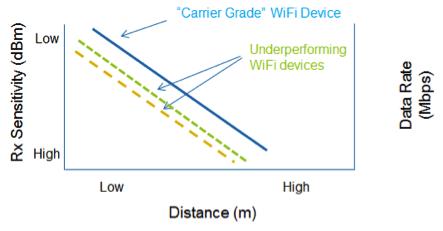
Figure 1 – Coverage Performance of Carrier Grade vs. Underperforming Wi-Fi Devices
By improving the RF component selection and design optimization in Wi-Fi devices, the achievable network throughput significantly improves. CableLabs is working with Industry bodies to determine reasonable performance thresholds for AP and Wi-Fi devices.
Current State of RF Certifications
At present, RF certification of Wi-Fi devices and access points is optional with no minimum performance standards. Original Equipment Manufacturers (OEMs) have the option whether to test their equipment against WFA standards or not. Although current test plans are thorough, they do not contain pass/fail or minimum performance levels requirements.
Currently, Federal Communications Commission (FCC) RF regulations are only intended to ensure public safety and non-interference with co-channel and adjacent channel systems. The regulations are designed for “not to exceed” power levels, not for minimum levels. In other words, the FCC focus has been on avoiding interference to other systems as opposed to requiring minimum performance requirements. The lack of receiver sensitivity tests does not provide assessment of end-user performance. In addition, FCC tests do not cover device throughput performance versus coverage or interference.
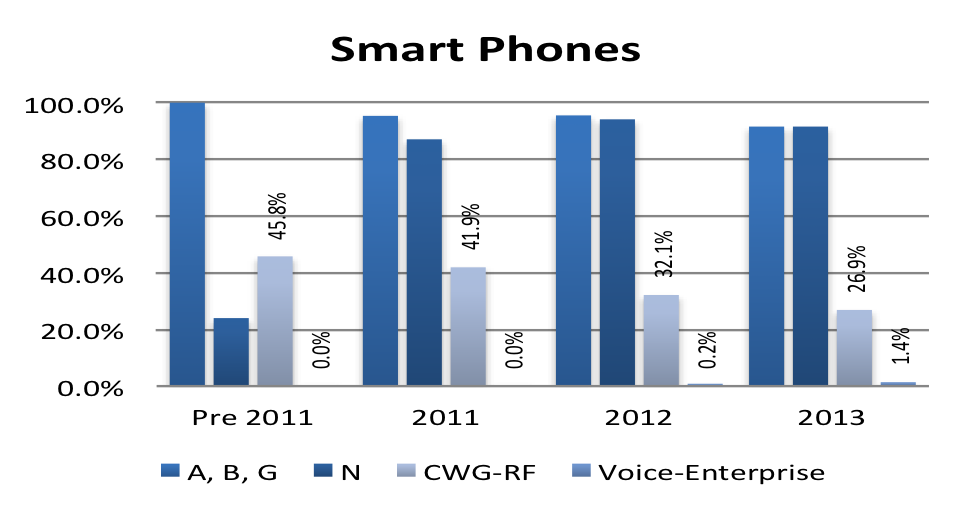
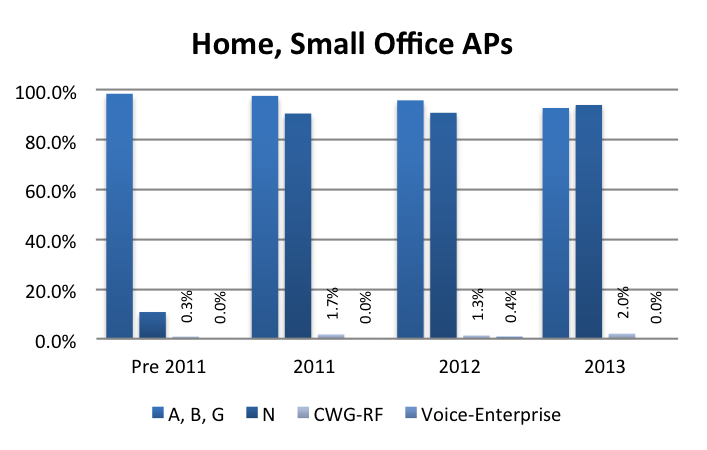
Figure 2 – CWG RF Certification Testing for Smart Phones, Home and Small Office APs
As shown in Figure 2, CWG RF certification testing of Wi-Fi devices has not been pursued by OEMs and device OEM participation is decreasing. CableLabs is working with industry bodies to recommend requiring that Wi-Fi devices meet minimum RF performance criteria during WFA RF testing and encourage RF certification testing.
CableLabs to Install RF Anechoic Chamber
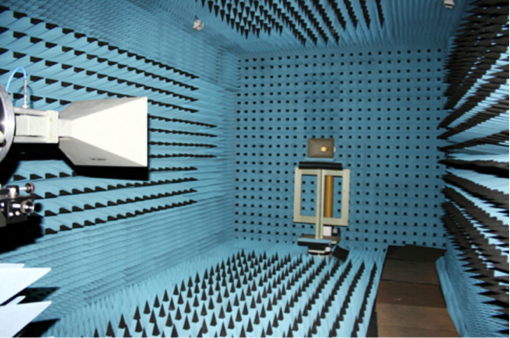
CableLabs is in the process of installing an in-house RF anechoic chamber with the capability to measure RF performance of Wi-Fi devices such as total isotropic sensitivity (TIS), total radiated power (TRP), Wi-Fi adjacent-/co-channel interference and LTE interference. Scheduled completion is late July 2014. Once complete, CableLabs will have the ability to test RF performance of all Wi-Fi devices. The RF chamber will be available to all member MSOs with the potential to lead Wi-Fi RF certification tests within the Wi-Fi industry.
Wi-Fi First Service Will Benefit from Carrier Grade Wi-Fi
Wi-Fi first service, a hybrid Wi-Fi/mobile service, where voice over Wi-Fi service is selected first over mobile voice service, is among the many new innovative services being introduced by Wi-Fi network operators. This service offers several technical challenges such as:
- Maintaining seamless Wi-Fi roaming and handover between Wi-Fi and 3G/4G networks
- Maintaining authentication and security across Wi-Fi and 3G/4G networks
- Supporting service profile across Wi-Fi and 3G/4G networks
- Providing efficient mobile device network discovery, selection, and attachment
- Delivering quality of service
Wi-Fi network operators are developing customized solutions to network architectures and target markets unique to their core business. As carrier grade Wi-Fi continues to gain momentum, it will offer improvement to Wi-Fi network quality and user experience. CableLabs is working with vendors and operators to develop solutions with emphasis on developing carrier grade Wi-Fi features.
Other Aspects of Carrier Grade Wi-Fi: What’s Next?
As carrier grade Wi-Fi continues to gain traction in the industry, CableLabs will maintain pace with standards body activities, product roadmaps, technology roadmaps, new services, business paradigms, and technology disruptors that will impact user experience and quality of Wi-Fi networks. Future blog posts will provide updates to carrier grade Wi-Fi features that may include:
- Solutions to Wi-Fi first network architectures and mobile applications
- Carrier Grade Wi-Fi WFA certifications
- IEEE 802.11 feature enhancements
- Carrier Grade best practices for Wi-Fi network planning, operation and performance
- Quality of Service
Mark Poletti is a Lead Wireless Architect with CableLabs. He has been addressing mobile operator design, operations and performance issues of 2G, 3G, 4G, and satellite networks for over 20 years. Mark is a member of the WFA and WBA and is focused on the wireless convergence of MSO and MNO networks.

